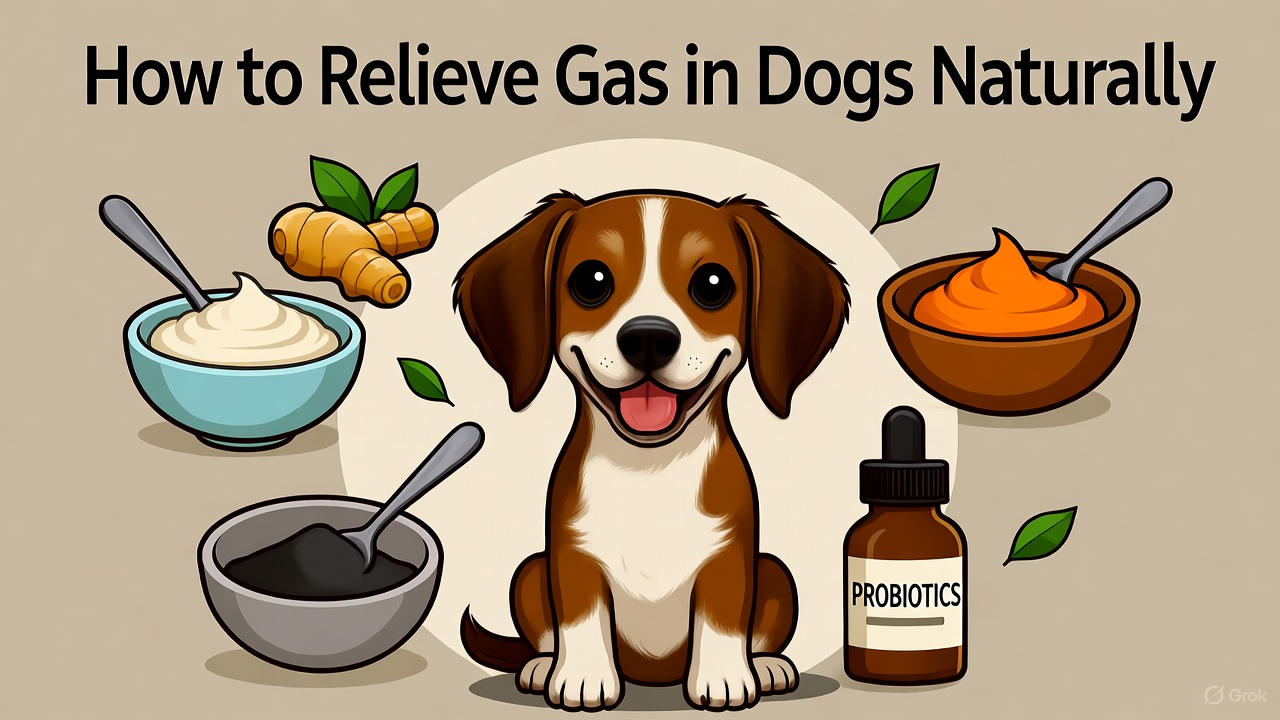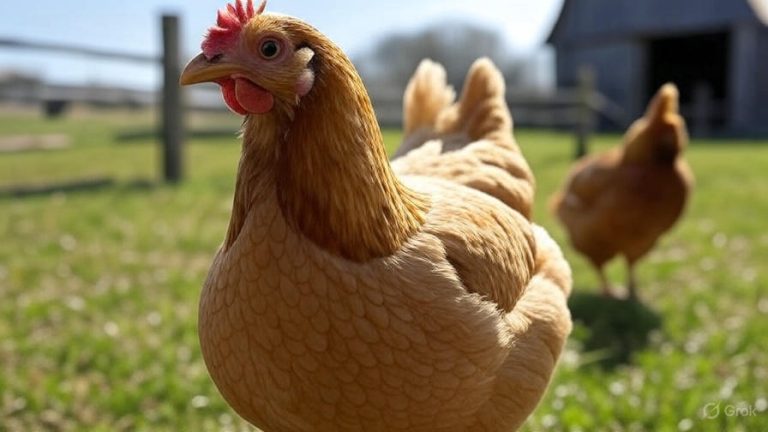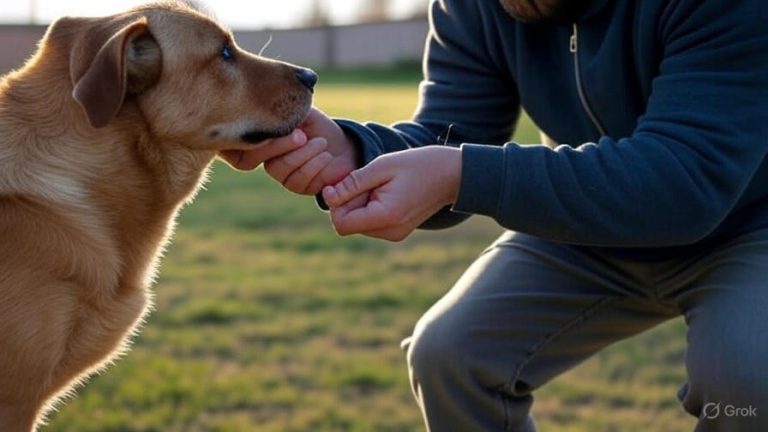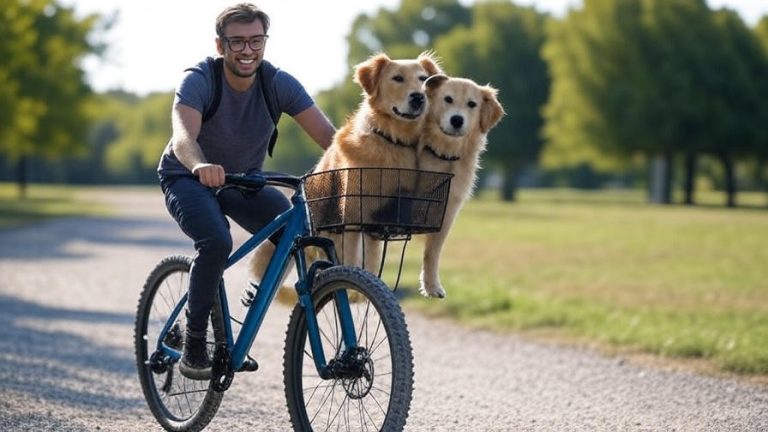How to Relieve Gas in Dogs Naturally?
Your dog just let out another loud toot, and the smell has cleared the room. You’ve noticed your furry friend seems uncomfortable, with a bloated belly and restless behavior. Dog flatulence is more than just an embarrassing moment—it can signal digestive discomfort that needs your attention.
Gas in dogs happens when air or fermentation gases build up in the digestive tract. While occasional toots are normal, excessive gas often means something in your dog’s diet or routine needs to change. The good news? You can help your pup feel better using simple, natural methods that work with their body instead of against it.
Why Dogs Get Gassy: The Root Causes
Dogs swallow air while eating and drinking, just like humans do. Fast eaters gulp down massive amounts of air along with their kibble. This swallowed air has to go somewhere, and it usually exits as flatulence or burping.
The food your dog eats plays a huge role in gas production. When certain ingredients reach the large intestine without being fully digested, bacteria ferment them. This fermentation process creates gases like methane and hydrogen sulfide—the compounds responsible for that rotten egg smell.
Certain breeds face higher risks for gas problems. Brachycephalic breeds like Bulldogs, Pugs, and Boston Terriers have flat faces that make them swallow more air when they eat. Deep-chested breeds like Great Danes and German Shepherds are prone to serious gas buildup that can lead to dangerous conditions.
Food intolerances cause significant gas issues in many dogs. Lactose intolerance is common since most adult dogs lack the enzyme needed to digest dairy products. Grain sensitivities and reactions to specific proteins can also trigger excessive flatulence and stomach upset.
Low-quality dog food packed with fillers, artificial ingredients, and hard-to-digest components often leads to gas. Ingredients like corn, wheat, soy, and meat byproducts can ferment in your dog’s gut, creating uncomfortable bloating and smelly gas.
Dietary Changes That Stop Gas at the Source
The quickest way to reduce dog flatulence starts with examining what goes into their bowl. High-quality dog food makes a dramatic difference in digestive health. Look for brands that list real meat as the first ingredient and avoid foods loaded with fillers and byproducts.
Highly digestible proteins help your dog’s system break down food efficiently. Chicken, turkey, fish, and lamb are easier for most dogs to process than beef or pork. When food digests properly, less material reaches the colon for bacteria to ferment.
Simple carbohydrates like sweet potato, pumpkin, and rice digest more smoothly than complex grains. Many dogs do well on limited-ingredient diets that remove common triggers. These diets feature a single protein source and one or two carbohydrate sources, making it easier to identify and eliminate problematic ingredients.
Eliminate table scraps and human food from your dog’s diet. Foods like beans, broccoli, cauliflower, and cabbage are notorious gas producers. Dairy products, fatty foods, and spicy dishes can upset your dog’s stomach and create excessive gas. Keep your pup on a consistent, high-quality diet designed specifically for canine digestion.
Sudden diet changes shock your dog’s digestive system and trigger gas, diarrhea, and vomiting. When you switch foods, do it gradually over 7-10 days. Start by mixing 25% new food with 75% old food for a few days. Then move to a 50-50 split, followed by 75% new food, and finally 100% new food. This slow transition gives your dog’s gut bacteria time to adjust.
Probiotics: The Gut Health Game Changer
Probiotics introduce beneficial bacteria into your dog’s digestive tract. These friendly microorganisms help break down food more efficiently, reducing the fermentation that causes gas. A balanced gut microbiome improves digestion and strengthens your dog’s immune system.
You can find probiotics in several forms. Dog-specific probiotic supplements come as powders, chewable tablets, or capsules. Plain, unsweetened yogurt with live active cultures provides natural probiotics that many dogs love. Kefir, a fermented milk drink, contains even more probiotic strains than yogurt.
Fermented vegetables like sauerkraut and kimchi (without spicy seasonings) offer probiotics and digestive enzymes. Start with tiny amounts—just a teaspoon for small dogs or a tablespoon for large dogs—mixed into their food. Too much too fast can actually cause more gas initially as the gut adjusts.
Probiotic supplements designed for dogs typically contain strains like Lactobacillus and Bifidobacterium. These strains have been studied for their benefits in canine digestive health. Follow the dosage recommendations on the package based on your dog’s weight.
Consistency matters with probiotics. Give them daily to maintain a healthy population of beneficial bacteria in your dog’s gut. You should notice improvements in gas, stool quality, and overall digestive comfort within a few weeks.
Digestive Enzymes That Break Down Food Better
Digestive enzymes help your dog’s body break down proteins, fats, and carbohydrates more completely. When food gets fully digested in the small intestine, less material reaches the colon where gas-producing bacteria live.
Natural sources of digestive enzymes include papaya, pineapple, and raw honey. Fresh papaya contains papain, an enzyme that breaks down proteins. Pineapple has bromelain, another protein-digesting enzyme. Small amounts of these fruits make healthy treats that support digestion.
Raw, unfiltered honey contains enzymes along with other beneficial compounds. A small lick of honey can support digestive function. Use only tiny amounts—about a quarter teaspoon for small dogs or half a teaspoon for large dogs.
Pumpkin stands out as a digestive superfood for dogs. Pure canned pumpkin (not pumpkin pie filling) contains fiber and natural enzymes that regulate digestion. It helps with both diarrhea and constipation, making it a versatile remedy. Mix one to four tablespoons into your dog’s food depending on their size.
You can also buy digestive enzyme supplements formulated for dogs. These products contain a blend of enzymes like protease, lipase, and amylase that work together to break down all types of food. Sprinkle the powder over your dog’s meals or give them as chewable tablets before eating.
Slowing Down Fast Eaters Reduces Swallowed Air
Dogs who inhale their food gulp down air with every bite. This swallowed air contributes significantly to gas and bloating. Fast eating can also lead to vomiting and, in severe cases, a life-threatening condition called gastric dilatation-volvulus (bloat).
Slow feeder bowls feature raised sections, mazes, or ridges that force your dog to eat around obstacles. These bowls turn mealtime into a puzzle, naturally slowing down your dog’s eating pace. Dogs must work to get each piece of kibble, which reduces air intake dramatically.
Puzzle feeders take this concept even further. These interactive toys dispense food as your dog manipulates them, making mealtime last 10-15 minutes instead of 30 seconds. This slower pace improves digestion and provides mental stimulation.
Spreading your dog’s food on a baking sheet or lick mat forces them to eat more slowly. The food spreads out so your dog can’t take huge mouthfuls. A snuffle mat, made of fabric strips where you hide kibble, taps into your dog’s natural foraging instincts while slowing their eating.
Splitting daily food into smaller, more frequent meals helps too. Instead of one or two large meals, feed your dog three or four smaller portions throughout the day. Smaller meals put less stress on the digestive system and reduce the amount of air swallowed at once.
Hand feeding might seem tedious, but it works wonders for extremely fast eaters. Give your dog a handful of kibble at a time, making them pause between portions. This method helps retrain your dog to eat at a calmer pace.
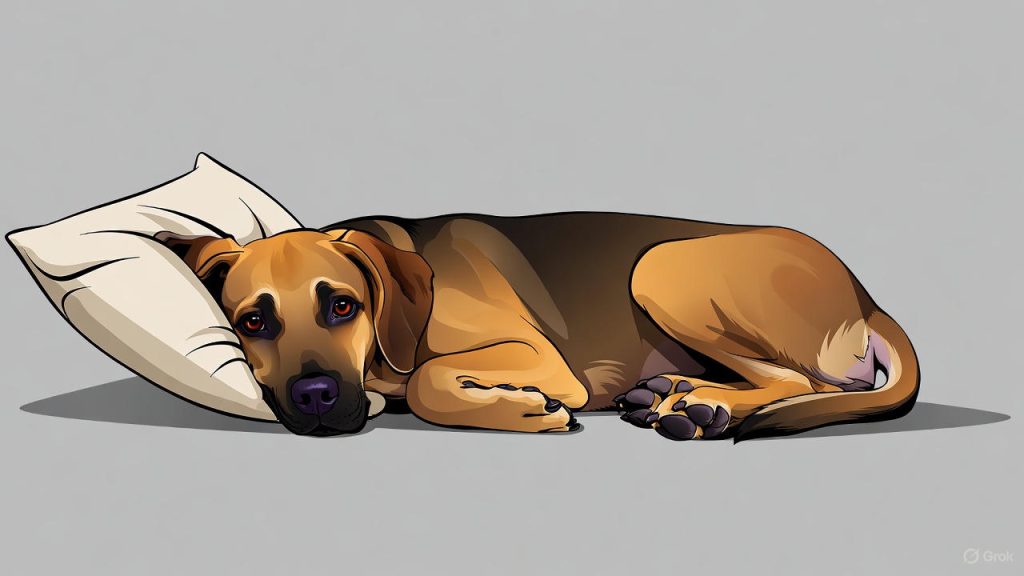
Exercise and Movement for Gas Relief
Physical activity helps move gas through your dog’s digestive tract. A gentle walk stimulates the intestines and encourages gas to pass naturally. The movement helps relieve pressure and discomfort from trapped gas.
Take your dog for a 10-15 minute walk about 30 minutes after meals. This light exercise aids digestion without causing the stomach upset that vigorous exercise after eating can trigger. The walk doesn’t need to be intense—a leisurely stroll works perfectly.
Avoid intense running, jumping, or playing immediately after your dog eats. Vigorous exercise on a full stomach increases the risk of bloat, especially in large, deep-chested breeds. Wait at least an hour after eating before engaging in high-energy activities.
Gentle belly rubs can also help move trapped gas. Use slow, circular motions on your dog’s abdomen, moving clockwise. This follows the natural direction of the digestive tract. Your dog will usually show you if the massage feels good or makes them uncomfortable.
Encouraging your dog to lie on different sides can help gas move and escape. If your dog seems gassy and uncomfortable, gently guide them to roll from one side to the other every few minutes.
Hydration Helps Everything Work Smoothly
Fresh, clean water supports every aspect of digestion. Proper hydration helps break down food, absorb nutrients, and move waste through the intestines. Dehydration slows digestion and can lead to constipation and gas buildup.
Make sure your dog always has access to clean water. Change the water at least twice daily and clean the bowl regularly. Some dogs drink more from running water fountains, which keep water fresh and appealing.
Check that your dog is drinking enough by monitoring their water bowl levels and watching for signs of dehydration. Healthy dogs typically need about one ounce of water per pound of body weight daily. A 20-pound dog should drink roughly 20 ounces of water.
The type of water bowl matters for some dogs. Elevated bowls help larger breeds drink without swallowing as much air. Wide, shallow bowls work better for flat-faced breeds that struggle with deep water dishes.
Herbs and Natural Supplements for Gas Relief
Several herbs have natural carminative properties, meaning they help expel gas from the digestive tract. These gentle remedies have been used for centuries in both human and veterinary medicine.
Ginger soothes the digestive tract and reduces gas, nausea, and inflammation. Fresh ginger root, ginger powder, or ginger tea (cooled) can be added to your dog’s food in small amounts. Use about a quarter teaspoon for small dogs or half a teaspoon for large dogs. Start with even less to make sure your dog tolerates it well.
Fennel seeds help relieve gas and bloating naturally. Crush a pinch of fennel seeds and sprinkle them over your dog’s food. You can also make fennel tea by steeping the seeds in hot water, letting it cool completely, and adding a small amount to your dog’s water bowl or food.
Peppermint has antispasmodic properties that relax the digestive tract muscles and help gas pass more easily. Use only fresh or dried peppermint leaves, never peppermint essential oil, which can be toxic to dogs. Steep the leaves in hot water to make a weak tea, cool it completely, and add a tablespoon or two to your dog’s food.
Chamomile calms the digestive system and reduces inflammation. This gentle herb helps with gas, stomach upset, and stress-related digestive issues. Brew chamomile tea, let it cool, and add a small amount to your dog’s meals or water.
Activated charcoal absorbs toxins and gases in the digestive tract. Dog-specific activated charcoal treats or supplements can reduce flatulence and bloating. Follow dosage instructions carefully, and don’t use it long-term without consulting your vet.
When Home Remedies Aren’t Enough
While natural remedies work for most cases of dog gas, some situations require professional help. Excessive gas accompanied by other symptoms might signal a more serious health problem.
Watch for warning signs like severe bloating, especially if your dog’s stomach looks swollen or feels hard. A distended abdomen combined with restlessness, drooling, unsuccessful attempts to vomit, or rapid breathing indicates a medical emergency. This could be bloat, which requires immediate veterinary attention.
Chronic diarrhea, vomiting, loss of appetite, or weight loss along with gas suggests digestive problems that need diagnosis and treatment. Conditions like inflammatory bowel disease, pancreatitis, or intestinal parasites require veterinary care.
Blood in the stool, black tarry stools, or persistent constipation are red flags. These symptoms indicate potential problems in the digestive tract that natural remedies can’t fix.
If your dog seems in pain—whining, panting excessively, refusing to lie down, or showing an arched back—don’t wait. Pain signals something more serious than simple gas.
Sudden onset of severe gas in a dog who normally doesn’t have this issue deserves attention. Your dog might have eaten something inappropriate or developed a food intolerance that needs addressing.
Your veterinarian can run tests to identify underlying causes of chronic gas. Blood work, stool samples, and imaging can reveal parasites, bacterial imbalances, organ problems, or digestive diseases. Once you have a diagnosis, you can develop a targeted treatment plan.
Prevention Strategies for Long-Term Gas Control
Keeping your dog gas-free long-term requires consistent habits and awareness. Maintaining a regular feeding schedule helps regulate digestion. Feed your dog at the same times each day so their digestive system can work on a predictable rhythm.
Store dog food properly in airtight containers to maintain freshness and prevent rancidity. Spoiled or rancid food can upset your dog’s stomach and cause gas. Check expiration dates and don’t buy more food than your dog can eat in a month or two.
Keep your dog at a healthy weight through proper portions and regular exercise. Overweight dogs often experience more digestive issues, including gas. Follow feeding guidelines on your dog food package and adjust based on your dog’s activity level and body condition.
Prevent your dog from eating too fast by using the slow-feeding methods mentioned earlier. Make these tools part of your regular routine, not just temporary fixes. Consistency trains your dog to eat at a healthier pace naturally.
Regular veterinary checkups catch developing problems early. Annual wellness exams (or twice-yearly for senior dogs) let your vet monitor your dog’s digestive health and overall wellbeing. Discuss any changes in your dog’s gas, stool quality, or eating habits.
Keep your dog away from garbage cans, compost bins, and other sources of inappropriate foods. Dogs who raid the trash or eat things they find on walks often end up with upset stomachs and excessive gas. Train a solid “leave it” command and supervise outdoor time.
Manage stress in your dog’s life. Anxiety and stress can affect digestion and increase gas. Provide a calm environment, regular exercise, mental stimulation, and plenty of positive attention. Some dogs benefit from calming supplements or anxiety-reducing techniques during stressful times.
Creating a Gas-Free Future for Your Dog
Dog gas doesn’t have to be something you just live with. Natural remedies and simple lifestyle changes can dramatically reduce your dog’s flatulence and improve their comfort and health. The strategies outlined here address both the symptoms and root causes of gas.
Start by evaluating your dog’s diet. Switch to high-quality, easily digestible food and make changes gradually. Add probiotics and digestive enzymes to support healthy gut function. Slow down fast eaters with special bowls or feeding methods that reduce swallowed air.
Use gentle exercise to help gas move through your dog’s system. Keep your dog well-hydrated and try natural herbs like ginger, fennel, or peppermint for occasional gas relief. Watch for warning signs that indicate when professional help is needed.
Be patient as you implement these changes. Your dog’s digestive system needs time to adjust to new foods, supplements, and routines. Most dogs show improvement within a few weeks, though some may need longer.
Every dog is different, so what works perfectly for one might not work as well for another. Pay attention to how your dog responds to each strategy. Keep a simple journal noting what you try and any changes in gas, stool quality, energy levels, and overall comfort.
The effort you put into solving your dog’s gas problem pays off in multiple ways. Your dog feels more comfortable, your home smells better, and you gain peace of mind knowing you’re supporting your pet’s digestive health. A happy gut means a happy dog, and a happy dog makes for a happy home.
Your dog depends on you to recognize problems and provide solutions. By taking a natural, holistic approach to gas relief, you’re working with your dog’s body to restore balance and comfort. These methods support long-term health rather than just masking symptoms.
You now have a complete toolkit of natural remedies and prevention strategies. Start with the changes that seem most relevant to your dog’s situation. Be consistent, stay observant, and don’t hesitate to consult your veterinarian if problems persist. Your gassy dog can find relief, and you can enjoy a fresher-smelling home while knowing you’re giving your furry friend the best possible care.

